Cover Page
Title Page
Copyright Page
brief contents
contents
Preface
Supplements and Media
part I Introduction
Chapter 1 The Science of Macroeconomics
1-1 What Macroeconomists Study
CASE STUDY The Historical Performance of the U.S. Economy
1-2 How Economists Think
Theory as Model Building
FYI Using Functions to Express Relationships Among Variables
The Use of Multiple Models
Prices: Flexible Versus Sticky
Microeconomic Thinking and Macroeconomic Models
FYI Nobel Macroeconomists
1-3 How This Book Proceeds
Chapter 2 The Data of Macroeconomics
2-1 Measuring the Value of Economic Activity: Gross Domestic Product
Income, Expenditure, and the Circular Flow
FYI Stocks and Flows
Rules for Computing GDP
Real GDP Versus Nominal GDP
Chain-Weighted Measures of Real GDP
The GDP Deflator
FYI Two Arithmetic Tricks for Working With Percentage Changes
The Components of Expenditure
FYI What Is Investment?
CASE STUDY GDP and Its Components
Other Measures of Income
Seasonal Adjustment
2-2 Measuring the Cost of Living: The Consumer Price Index
The Price of a Basket of Goods
The CPI Versus the GDP Deflator
Does the CPI Overstate Inflation?
CASE STUDY The Billion Prices Project
2-3 Measuring Joblessness: The Unemployment Rate
The Household Survey
CASE STUDY Trends in Labor-Force Participation
The Establishment Survey
2-4 Conclusion: From Economic Statistics to Economic Models
part II Classical Theory: The Economy in the Long Run
Chapter 3 National Income: Where It Comes From and Where It Goes
3-1 What Determines the Total Production of Goods and Services?
The Factors of Production
The Production Function
The Supply of Goods and Services
3-2 How Is National Income Distributed to the Factors of Production?
Factor Prices
The Decisions Facing a Competitive Firm
The Firm’s Demand for Factors
The Division of National Income
CASE STUDY The Black Death and Factor Prices
The Cobb—Douglas Production Function
FYI The Growing Gap Between Rich and Poor
CASE STUDY Labor Productivity as the Key Determinant of Real Wages
3-3 What Determines the Demand for Goods and Services?
Consumption
Investment
FYI The Many Different Interest Rates
Government Purchases
3-4 What Brings the Supply and Demand for Goods and Services Into Equilibrium?
Equilibrium in the Market for Goods and Services: The Supply and Demand for the Economy’s Output
Equilibrium in the Financial Markets: The Supply and Demand for Loanable Funds
Changes in Saving: The Effects of Fiscal Policy
CASE STUDY Wars and Interest Rates in the United Kingdom, 1730–1920
Changes in Investment Demand
3-5 Conclusion
Chapter 4 The Monetary System: What It Is and How It Works
4-1 What Is Money?
The Functions of Money
The Types of Money
CASE STUDY Money in a POW Camp
The Development of Fiat Money
CASE STUDY Money and Social Conventions on the Island of Yap
How the Quantity of Money Is Controlled
How the Quantity of Money Is Measured
FYI How Do Credit Cards and Debit Cards Fit Into the Monetary System?
4-2 The Role of Banks in the Monetary System
100-Percent-Reserve Banking
Fractional-Reserve Banking
Bank Capital, Leverage, and Capital Requirements
4-3 How Central Banks Influence the Money Supply
A Model of the Money Supply
The Instruments of Monetary Policy
CASE STUDY Quantitative Easing and the Exploding Monetary Base
Problems in Monetary Control
CASE STUDY Bank Failures and the Money Supply in the 1930s
4-4 Conclusion
Chapter 5 Inflation: Its Causes, Effects, and Social Costs
5-1 The Quantity Theory of Money
Transactions and the Quantity Equation
From Transactions to Income
The Money Demand Function and the Quantity Equation
The Assumption of Constant Velocity
Money, Prices, and Inflation
CASE STUDY Inflation and Money Growth
5-2 Seigniorage: The Revenue From Printing Money
CASE STUDY Paying for the American Revolution
5-3 Inflation and Interest Rates
Two Interest Rates: Real and Nominal
The Fisher Effect
CASE STUDY Inflation and Nominal Interest Rates
Two Real Interest Rates: Ex Ante and Ex Post
CASE STUDY Nominal Interest Rates in the Nineteenth Century
5-4 The Nominal Interest Rate and the Demand for Money
The Cost of Holding Money
Future Money and Current Prices
5-5 The Social Costs of Inflation
The Layman’s View and the Classical Response
CASE STUDY What Economists and the Public Say About Inflation
The Costs of Expected Inflation
The Costs of Unexpected Inflation
CASE STUDY The Free Silver Movement, the Election of 1896, and The Wizard of Oz
One Benefit of Inflation
5-6 Hyperinflation
The Costs of Hyperinflation
The Causes of Hyperinflation
CASE STUDY Hyperinflation in Interwar Germany
CASE STUDY Hyperinflation in Zimbabwe
5-7 Conclusion: The Classical Dichotomy
Appendix: The Cagan Model: How Current and Future Money Affect the Price Level
Chapter 6 The Open Economy
6-1 The International Flows of Capital and Goods
The Role of Net Exports
International Capital Flows and the Trade Balance
International Flows of Goods and Capital: An Example
FYI The Irrelevance of Bilateral Trade Balances
6-2 Saving and Investment in a Small Open Economy
Capital Mobility and the World Interest Rate
Why Assume a Small Open Economy?
The Model
How Policies Influence the Trade Balance
Evaluating Economic Policy
CASE STUDY The U.S. Trade Deficit
CASE STUDY Why Doesn’t Capital Flow to Poor Countries?
6-3 Exchange Rates
Nominal and Real Exchange Rates
The Real Exchange Rate and the Trade Balance
The Determinants of the Real Exchange Rate
How Policies Influence the Real Exchange Rate
The Effects of Trade Policies
The Determinants of the Nominal Exchange Rate
CASE STUDY Inflation and Nominal Exchange Rates
The Special Case of Purchasing-Power Parity
CASE STUDY The Big Mac Around the World
6-4 Conclusion: The United States as a Large Open Economy
Appendix: The Large Open Economy
Net Capital Outflow
The Model
Policies in the Large Open Economy
Conclusion
Chapter 7 Unemployment
7-1 Job Loss, Job Finding, and the Natural Rate of Unemployment
7-2 Job Search and Frictional Unemployment
Causes of Frictional Unemployment
Public Policy and Frictional Unemployment
CASE STUDY Unemployment Insurance and the Rate of Job Finding
7-3 Real-Wage Rigidity and Structural Unemployment
Minimum-Wage Laws
CASE STUDY The Characteristics of Minimum-Wage Workers
Unions and Collective Bargaining
Efficiency Wages
CASE STUDY Henry Ford’s $5 Workday
7-4 Labor-Market Experience: The United States
The Duration of Unemployment
CASE STUDY The Increase in U.S. Long-Term Unemployment and the Debate Over Unemployment Insurance
Variation in the Unemployment Rate Across Demographic Groups
Transitions Into and Out of the Labor Force
7-5 Labor-Market Experience: Europe
The Rise in European Unemployment
Unemployment Variation Within Europe
CASE STUDY The Secrets to Happiness
The Rise of European Leisure
7-6 Conclusion
part III Growth Theory: The Economy in the Very Long Run
Chapter 8 Economic Growth I: Capital Accumulation and Population Growth
8-1 The Accumulation of Capital
The Supply and Demand for Goods
Growth in the Capital Stock and the Steady State
Approaching the Steady State: A Numerical Example
CASE STUDY The Miracle of Japanese and German Growth
How Saving Affects Growth
CASE STUDY Saving and Investment Around the World
8-2 The Golden Rule Level of Capital
Comparing Steady States
Finding the Golden Rule Steady State: A Numerical Example
The Transition to the Golden Rule Steady State
8-3 Population Growth
The Steady State With Population Growth
The Effects of Population Growth
CASE STUDY Population Growth Around the World
Alternative Perspectives on Population Growth
8-4 Conclusion
Chapter 9 Economic Growth II: Technology, Empirics, and Policy
9-1 Technological Progress in the Solow Model
The Efficiency of Labor
The Steady State With Technological Progress
The Effects of Technological Progress
9-2 From Growth Theory to Growth Empirics
Balanced Growth
Convergence
Factor Accumulation Versus Production Efficiency
CASE STUDY Is Free Trade Good for Economic Growth?
9-3 Policies to Promote Growth
Evaluating the Rate of Saving
Changing the Rate of Saving
Allocating the Economy’s Investment
CASE STUDY Industrial Policy in Practice
Establishing the Right Institutions
CASE STUDY The Colonial Origins of Modern Institutions
Encouraging Technological Progress
CASE STUDY The Worldwide Slowdown in Economic Growth
9-4 Beyond the Solow Model: Endogenous Growth Theory
The Basic Model
A Two-Sector Model
The Microeconomics of Research and Development
The Process of Creative Destruction
9-5 Conclusion
Appendix: Accounting for the Sources of Economic Growth
Increases in the Factors of Production
Technological Progress
The Sources of Growth in the United States
CASE STUDY Growth in the East Asian Tigers
The Solow Residual in the Short Run
part IV Business Cycle Theory: The Economy in the Short Run
Chapter 10 Introduction to Economic Fluctuations
10-1 The Facts About the Business Cycle
GDP and Its Components
Unemployment and Okun’s Law
Leading Economic Indicators
10-2 Time Horizons in Macroeconomics
How the Short Run and Long Run Differ
CASE STUDY If You Want to Know Why Firms Have Sticky Prices, Ask Them
The Model of Aggregate Supply and Aggregate Demand
10-3 Aggregate Demand
The Quantity Equation as Aggregate Demand
Why the Aggregate Demand Curve Slopes Downward
Shifts in the Aggregate Demand Curve
10-4 Aggregate Supply
The Long Run: The Vertical Aggregate Supply Curve
The Short Run: The Horizontal Aggregate Supply Curve
From the Short Run to the Long Run
CASE STUDY A Monetary Lesson From French History
FYI David Hume on the Real Effects of Money
10-5 Stabilization Policy
Shocks to Aggregate Demand
Shocks to Aggregate Supply
CASE STUDY How OPEC Helped Cause Stagflation in the 1970s and Euphoria in the 1980s
10-6 Conclusion
Chapter 11 Aggregate Demand I: Building the IS–LM Model
11-1 The Goods Market and the IS Curve
The Keynesian Cross
CASE STUDY Cutting Taxes to Stimulate the Economy: The Kennedy and Bush Tax Cuts
CASE STUDY Increasing Government Purchases to Stimulate the Economy: The Obama Spending Plan
The Interest Rate, Investment, and the IS Curve
How Fiscal Policy Shifts the IS Curve
11-2 The Money Market and the LM Curve
The Theory of Liquidity Preference
CASE STUDY Does a Monetary Tightening Raise or Lower Interest Rates?
Income, Money Demand, and the LM Curve
How Monetary Policy Shifts the LM Curve
11-3 Conclusion: The Short-Run Equilibrium
Chapter 12 Aggregate Demand II: Applying the IS–LM Model
12-1 Explaining Fluctuations With the IS–LM Model
How Fiscal Policy Shifts the IS Curve and Changes the Short-Run Equilibrium
How Monetary Policy Shifts the LM Curve and Changes the Short-Run Equilibrium
The Interaction Between Monetary and Fiscal Policy
CASE STUDY Policy Analysis With Macroeconometric Models
Shocks in the IS–LM Model
CASE STUDY The U.S. Recession of 2001
What Is the Fed’s Policy Instrument—The Money Supply or the Interest Rate?
12-2 IS–LM as a Theory of Aggregate Demand
From the IS–LM Model to the Aggregate Demand Curve
The IS–LM Model in the Short Run and Long Run
12-3 The Great Depression
The Spending Hypothesis: Shocks to the IS Curve
The Money Hypothesis: A Shock to the LM Curve
The Money Hypothesis Again: The Effects of Falling Prices
Could the Depression Happen Again?
CASE STUDY The Financial Crisis and Economic Downturn of 2008 and 2009
FYI The Liquidity Trap (Also Known as the Zero Lower Bound)
12-4 Conclusion
Chapter 13 The Open Economy Revisited: The Mundell–Fleming Model and the Exchange-Rate Regime
13-1 The Mundell–Fleming Model
The Key Assumption: Small Open Economy With Perfect Capital Mobility
The Goods Market and the IS* Curve
The Money Market and the LM* Curve
Putting the Pieces Together
13-2 The Small Open Economy Under Floating Exchange Rates
Fiscal Policy
Monetary Policy
Trade Policy
13-3 The Small Open Economy Under Fixed Exchange Rates
How a Fixed-Exchange-Rate System Works
CASE STUDY The International Gold Standard
Fiscal Policy
Monetary Policy
CASE STUDY Devaluation and the Recovery From the Great Depression
Trade Policy
Policy in the Mundell–Fleming Model: A Summary
13-4 Interest Rate Differentials
Country Risk and Exchange-Rate Expectations
Differentials in the Mundell–Fleming Model
CASE STUDY International Financial Crisis: Mexico 1994–1995
CASE STUDY International Financial Crisis: Asia 1997–1998
13-5 Should Exchange Rates Be Floating or Fixed?
Pros and Cons of Different Exchange-Rate Systems
CASE STUDY The Debate Over the Euro
Speculative Attacks, Currency Boards, and Dollarization
The Impossible Trinity
CASE STUDY The Chinese Currency Controversy
13-6 From the Short Run to the Long Run: The Mundell–Fleming Model With a Changing Price Level
13-7 A Concluding Reminder
Appendix: A Short-Run Model of the Large Open Economy
Fiscal Policy
Monetary Policy
A Rule of Thumb
Chapter 14 Aggregate Supply and the Short-Run Tradeoff Between Inflation and Unemployment
14-1 The Basic Theory of Aggregate Supply
The Sticky-Price Model
An Alternative Theory: The Imperfect-Information Model
CASE STUDY International Differences in the Aggregate Supply Curve
Implications
14-2 Inflation, Unemployment, and the Phillips Curve
Deriving the Phillips Curve From the Aggregate Supply Curve
FYI The History of the Modern Phillips Curve
Adaptive Expectations and Inflation Inertia
Two Causes of Rising and Falling Inflation
CASE STUDY Inflation and Unemployment in the United States
The Short-Run Tradeoff Between Inflation and Unemployment
FYI How Precise Are Estimates of the Natural Rate of Unemployment?
Disinflation and the Sacrifice Ratio
Rational Expectations and the Possibility of Painless Disinflation
CASE STUDY The Sacrifice Ratio in Practice
Hysteresis and the Challenge to the Natural-Rate Hypothesis
14-3 Conclusion
Appendix: The Mother of All Models
part V Topics in Macroeconomic Theory
Chapter 15 A Dynamic Model of Aggregate Demand and Aggregate Supply
15-1 Elements of the Model
Output: The Demand for Goods and Services
The Real Interest Rate: The Fisher Equation
Inflation: The Phillips Curve
Expected Inflation: Adaptive Expectations
The Nominal Interest Rate: The Monetary-Policy Rule
CASE STUDY The Taylor Rule
15-2 Solving the Model
The Long-Run Equilibrium
The Dynamic Aggregate Supply Curve
The Dynamic Aggregate Demand Curve
The Short-Run Equilibrium
15-3 Using the Model
Long-Run Growth
A Shock to Aggregate Supply
FYI The Numerical Calibration and Simulation
A Shock to Aggregate Demand
A Shift in Monetary Policy
15-4 Two Applications: Lessons for Monetary Policy
The Tradeoff Between Output Variability and Inflation Variability
CASE STUDY The Fed Versus the European Central Bank
The Taylor Principle
CASE STUDY What Caused the Great Inflation?
15-5 Conclusion: Toward DSGE Models
Chapter 16 Understanding Consumer Behavior
16-1 John Maynard Keynes and the Consumption Function
Keynes’s Conjectures
The Early Empirical Successes
Secular Stagnation, Simon Kuznets, and the Consumption Puzzle
16-2 Irving Fisher and Intertemporal Choice
The Intertemporal Budget Constraint
FYI Present Value, or Why a $1,000,000 Prize Is Worth Only $623,000
Consumer Preferences
Optimization
How Changes in Income Affect Consumption
How Changes in the Real Interest Rate Affect Consumption
Constraints on Borrowing
16-3 Franco Modigliani and the Life-Cycle Hypothesis
The Hypothesis
Implications
CASE STUDY The Consumption and Saving of the Elderly
16-4 Milton Friedman and the Permanent-Income Hypothesis
The Hypothesis
Implications
CASE STUDY The 1964 Tax Cut and the 1968 Tax Surcharge
CASE STUDY The Tax Rebates of 2008
16-5 Robert Hall and the Random-Walk Hypothesis
The Hypothesis
Implications
CASE STUDY Do Predictable Changes in Income Lead to Predictable Changes in Consumption?
16-6 David Laibson and the Pull of Instant Gratification
CASE STUDY How to Get People to Save More
16-7 Conclusion
Chapter 17 The Theory of Investment
17-1 Business Fixed Investment
The Rental Price of Capital
The Cost of Capital
The Determinants of Investment
Taxes and Investment
The Stock Market and Tobin’s q
CASE STUDY The Stock Market as an Economic Indicator
Alternative Views of the Stock Market: The Efficient Markets Hypothesis Versus Keynes’s Beauty Contest
Financing Constraints
17-2 Residential Investment
The Stock Equilibrium and the Flow Supply
Changes in Housing Demand
17-3 Inventory Investment
Reasons for Holding Inventories
How the Real Interest Rate and Credit Conditions Affect Inventory Investment
17-4 Conclusion
part VI Topics in Macroeconomic Policy
Chapter 18 Alternative Perspectives on Stabilization Policy
18-1 Should Policy Be Active or Passive?
Lags in the Implementation and Effects of Policies
The Difficult Job of Economic Forecasting
CASE STUDY Mistakes in Forecasting
Ignorance, Expectations, and the Lucas Critique
The Historical Record
CASE STUDY Is the Stabilization of the Economy a Figment of the Data?
18-2 Should Policy Be Conducted by Rule or by Discretion?
Distrust of Policymakers and the Political Process
The Time Inconsistency of Discretionary Policy
CASE STUDY Alexander Hamilton Versus Time Inconsistency
Rules for Monetary Policy
CASE STUDY Inflation Targeting: Rule or Constrained Discretion?
CASE STUDY Central-Bank Independence
18-3 Conclusion: Making Policy in an Uncertain World
Appendix: Time Inconsistency and the Tradeoff Between Inflation and Unemployment
Chapter 19 Government Debt and Budget Deficits
19-1 The Size of the Government Debt
CASE STUDY The Troubling Long-Term Outlook for Fiscal Policy
19-2 Problems in Measurement
Measurement Problem 1: Inflation
Measurement Problem 2: Capital Assets
Measurement Problem 3: Uncounted Liabilities
Measurement Problem 4: The Business Cycle
Summing Up
19-3 The Traditional View of Government Debt
FYI Taxes and Incentives
19-4 The Ricardian View of Government Debt
The Basic Logic of Ricardian Equivalence
Consumers and Future Taxes
CASE STUDY George Bush’s Withholding Experiment
CASE STUDY Why Do Parents Leave Bequests?
Making a Choice
FYI Ricardo on Ricardian Equivalence
19-5 Other Perspectives on Government Debt
Balanced Budgets Versus Optimal Fiscal Policy
Fiscal Effects on Monetary Policy
Debt and the Political Process
International Dimensions
CASE STUDY The Benefits of Indexed Bonds
19-6 Conclusion
Chapter 20 The Financial System: Opportunities and Dangers
20-1 What Does the Financial System Do?
Financing Investment
Sharing Risk
Dealing With Asymmetric Information
Fostering Economic Growth
CASE STUDY Microfinance: Professor Yunus’s Profound Idea
20-2 Financial Crises
The Anatomy of a Crisis
FYI The TED Spread
CASE STUDY Who Should Be Blamed for the Financial Crisis of 2008–2009?
Policy Responses to a Crisis
Policies to Prevent Crises
FYI CoCo Bonds
CASE STUDY The European Sovereign Debt Crisis
20-3 Conclusion
Epilogue What We Know, What We Don’t
The Four Most Important Lessons of Macroeconomics
Lesson 1: In the long run, a country’s capacity to produce goods and services determines the standard of living of its citizens.
Lesson 2: In the short run, aggregate demand influences the amount of goods and services that a country produces.
Lesson 3: In the long run, the rate of money growth determines the rate of inflation, but it does not affect the rate of unemployment.
Lesson 4: In the short run, policymakers who control monetary and fiscal policy face a tradeoff between inflation and unemployment.
The Four Most Important Unresolved Questions of Macroeconomics
Question 1: How should policymakers try to promote growth in the economy’s natural level of output?
Question 2: Should policymakers try to stabilize the economy? If so, how?
Question 3: How costly is inflation, and how costly is reducing inflation?
Question 4: How big a problem are government budget deficits?
Conclusion
Glossary
Index
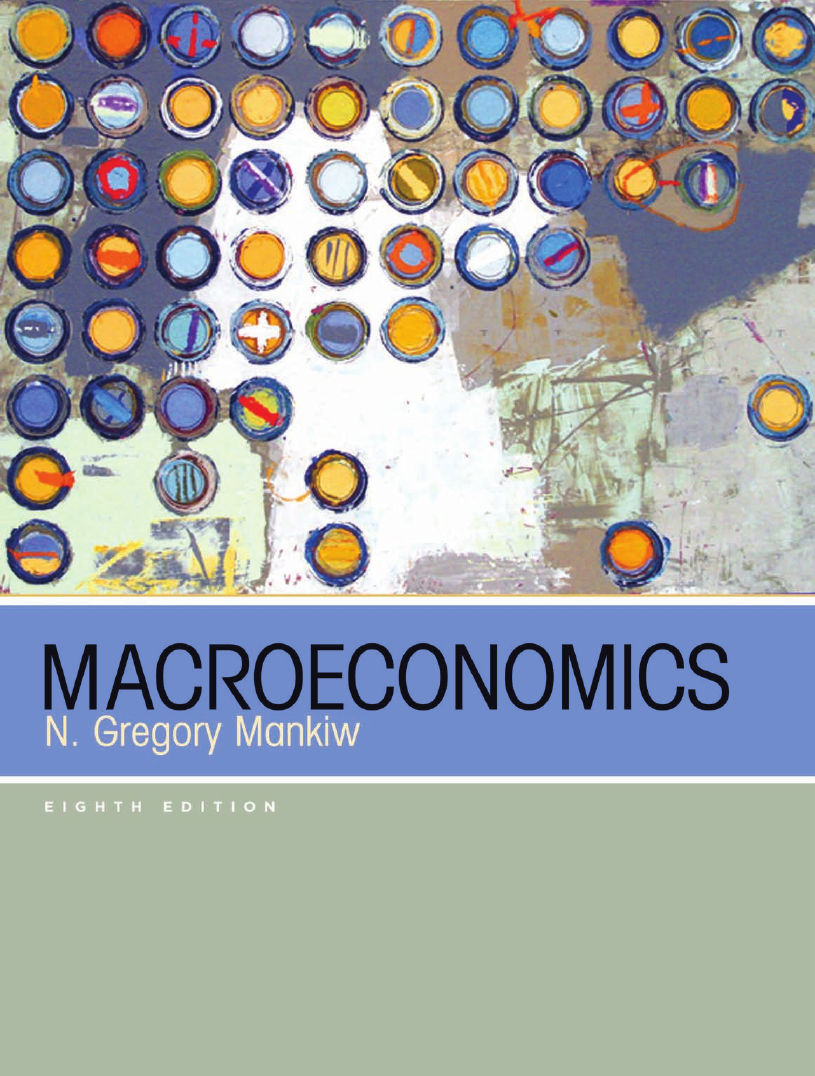
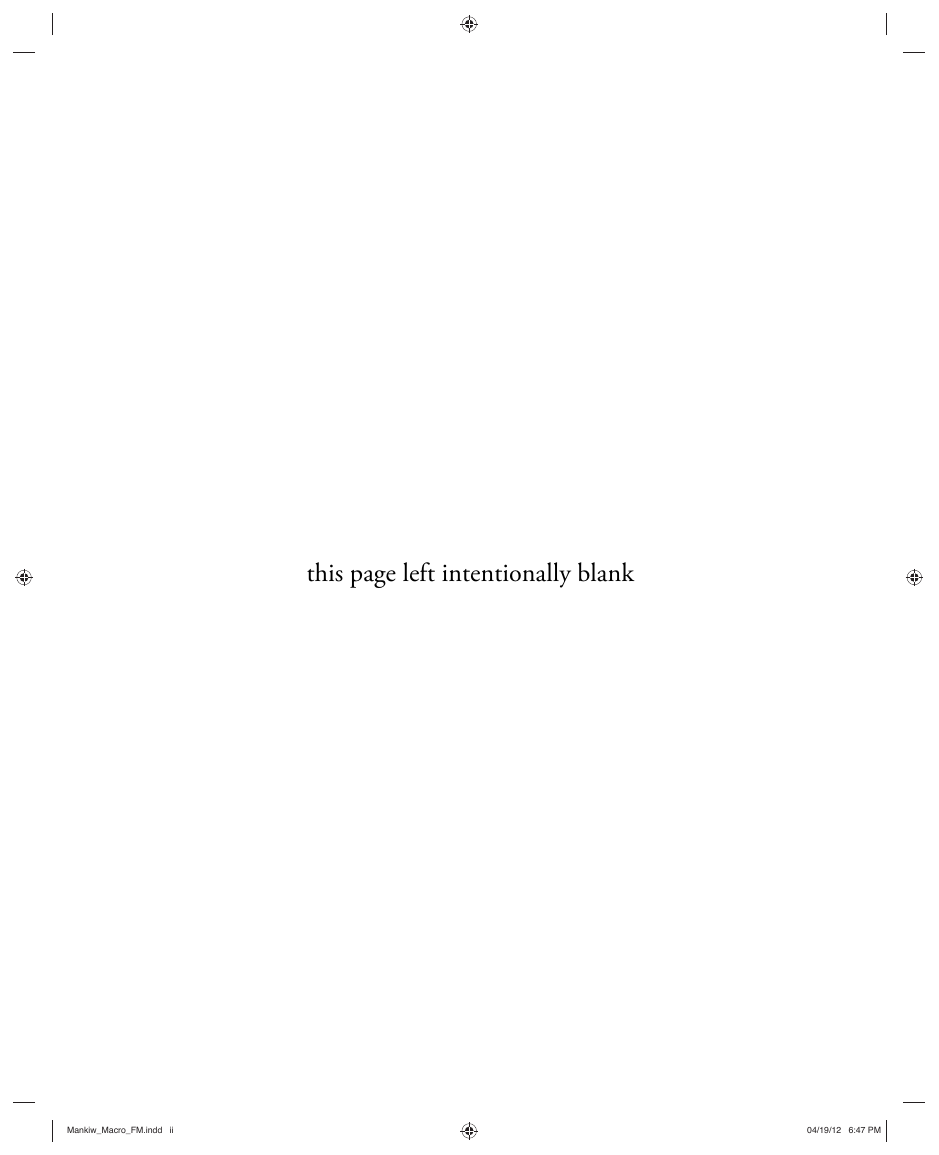
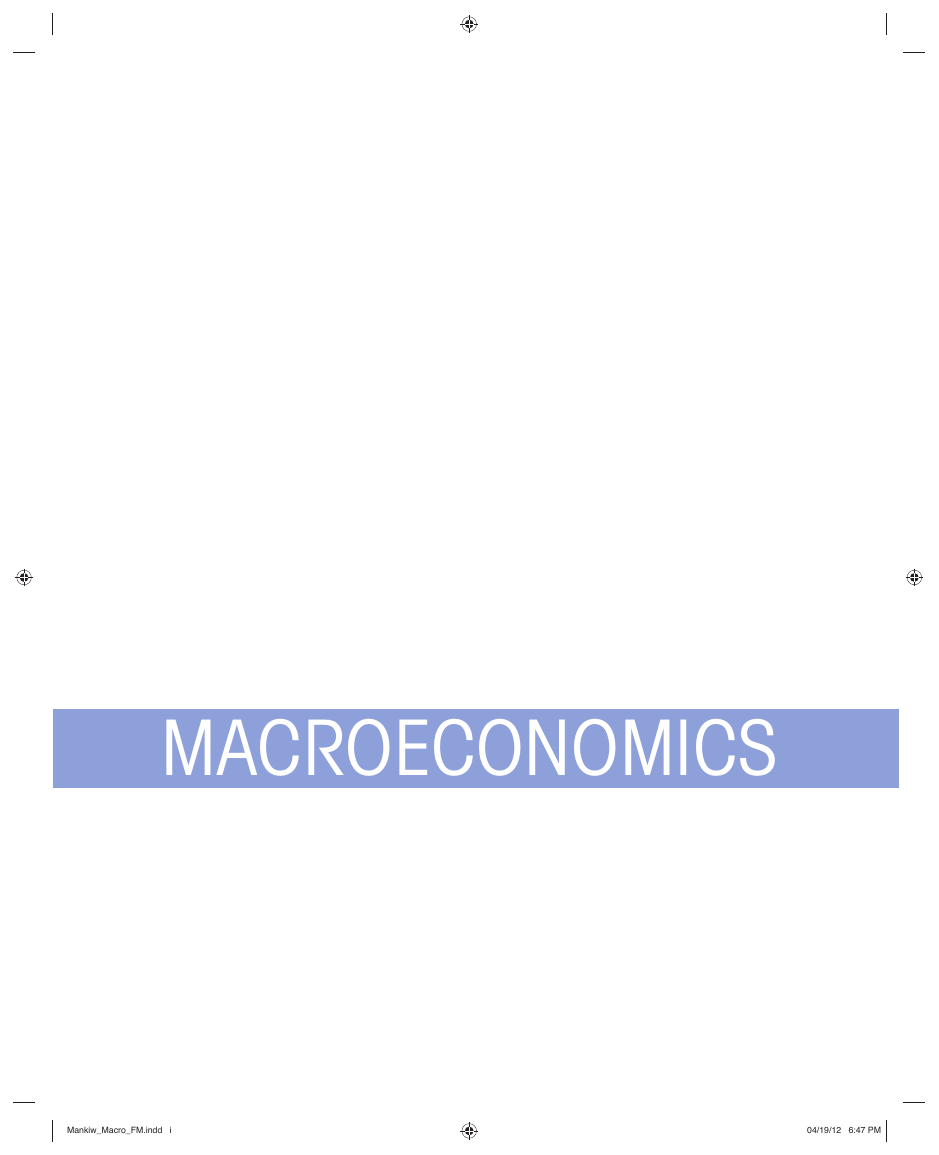
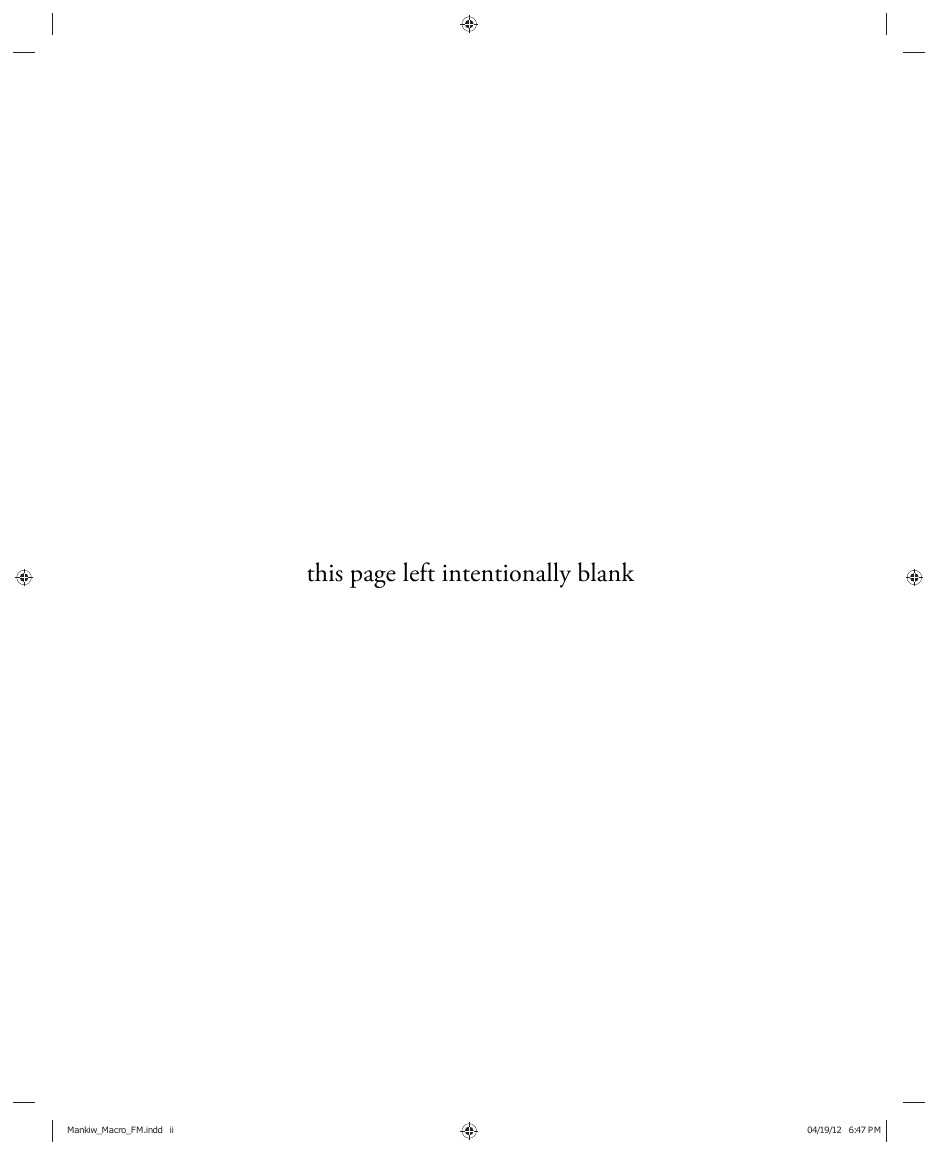
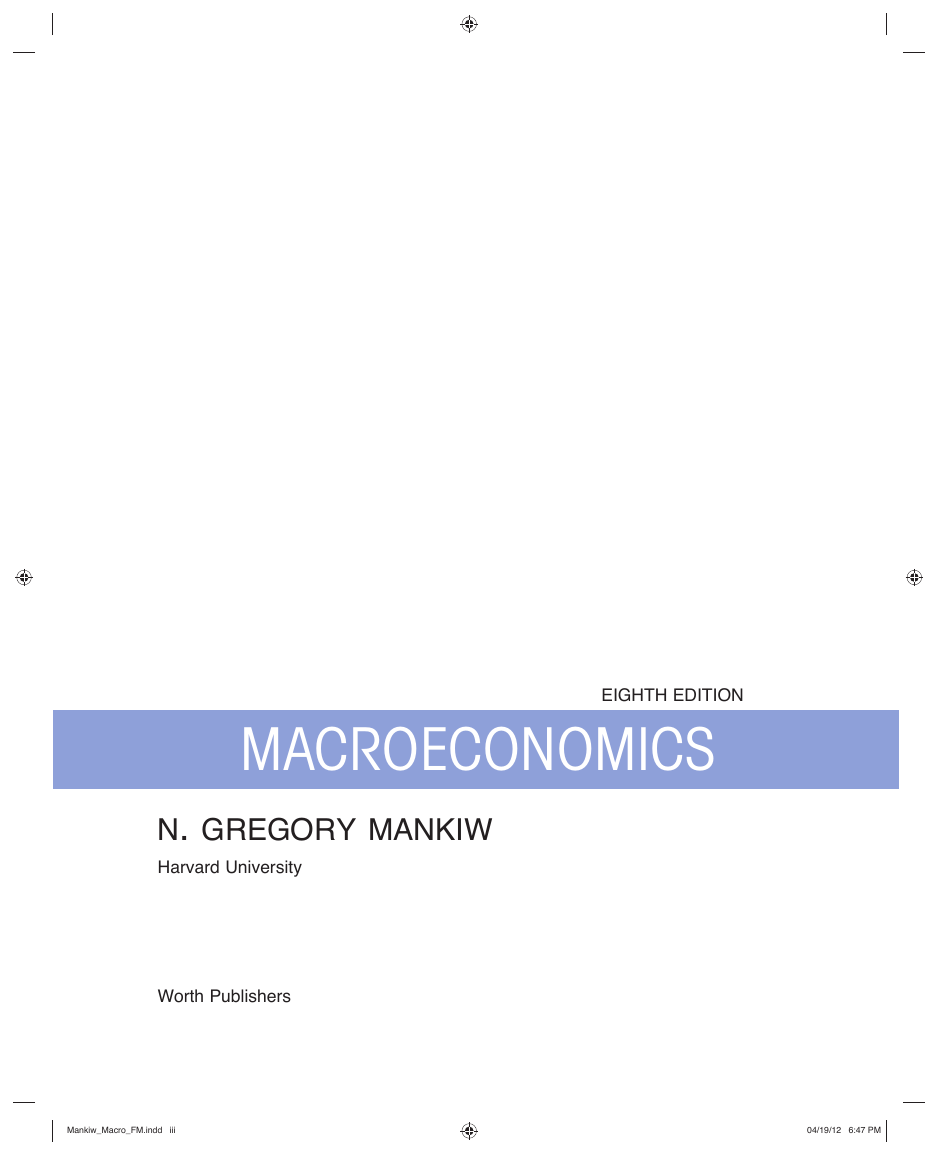
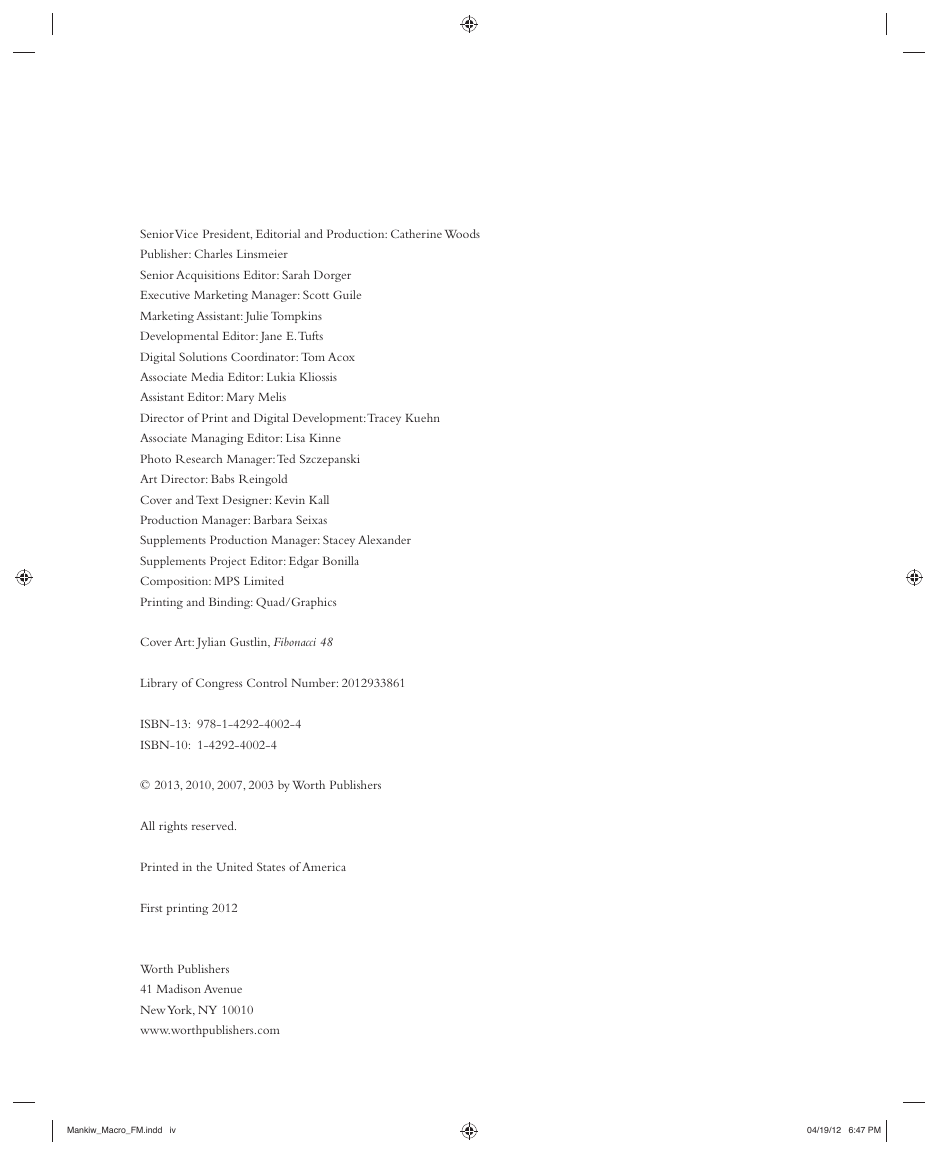
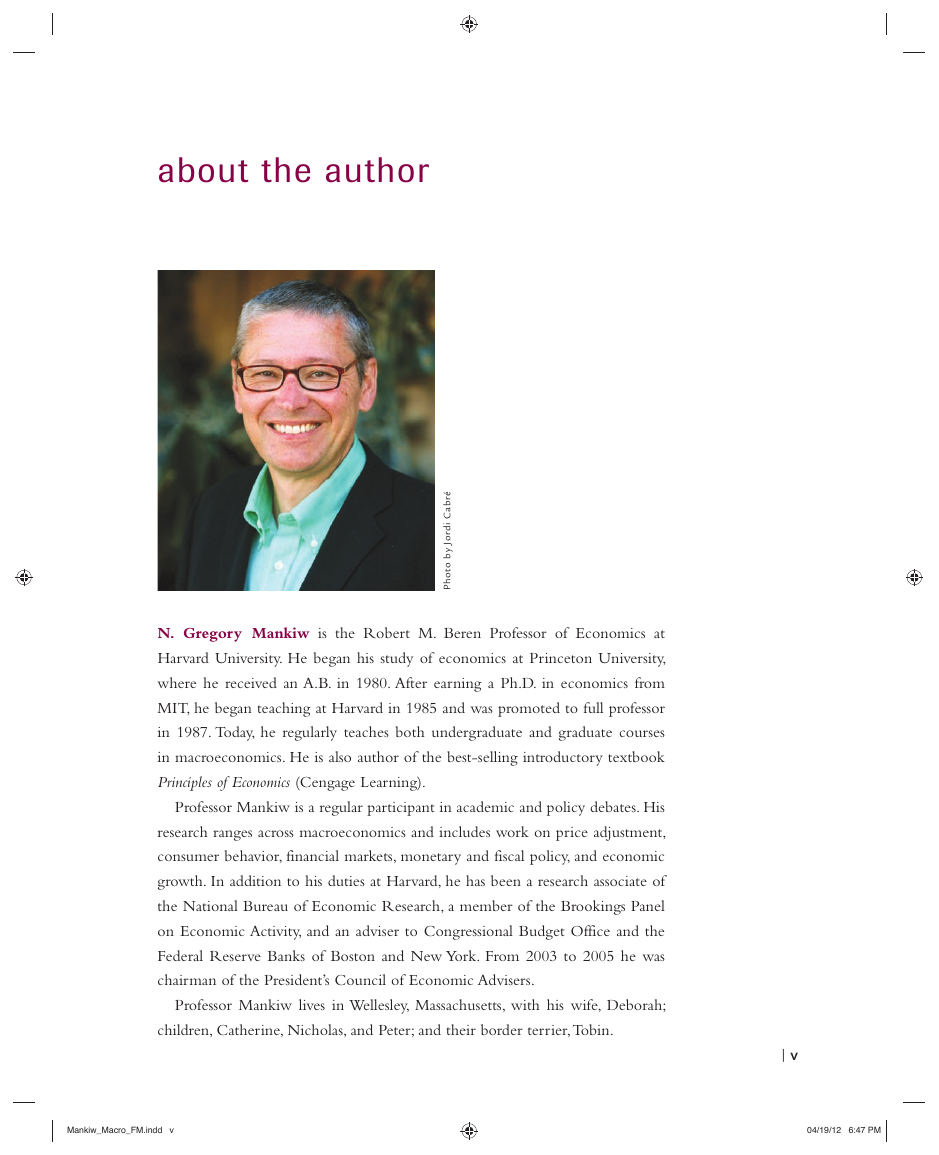
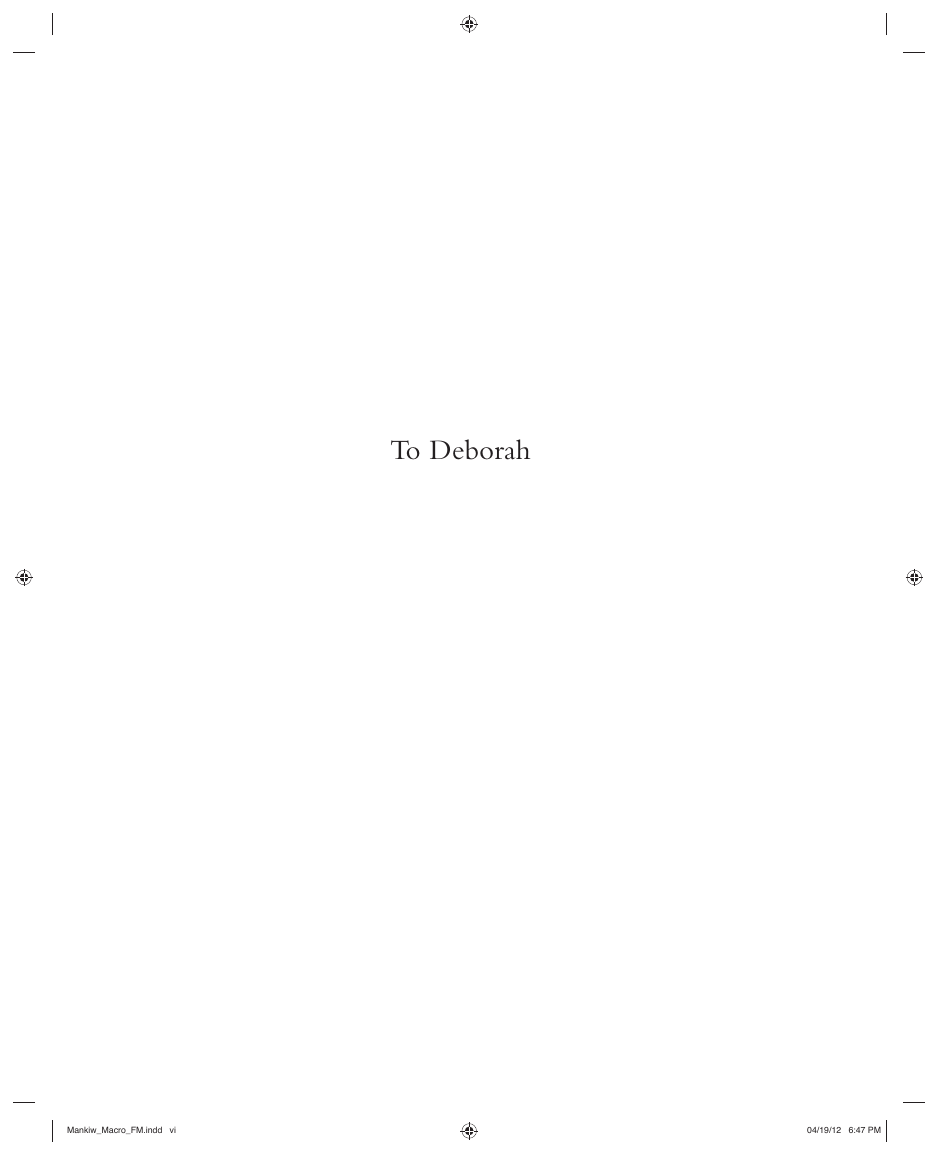








 2023年江西萍乡中考道德与法治真题及答案.doc
2023年江西萍乡中考道德与法治真题及答案.doc 2012年重庆南川中考生物真题及答案.doc
2012年重庆南川中考生物真题及答案.doc 2013年江西师范大学地理学综合及文艺理论基础考研真题.doc
2013年江西师范大学地理学综合及文艺理论基础考研真题.doc 2020年四川甘孜小升初语文真题及答案I卷.doc
2020年四川甘孜小升初语文真题及答案I卷.doc 2020年注册岩土工程师专业基础考试真题及答案.doc
2020年注册岩土工程师专业基础考试真题及答案.doc 2023-2024学年福建省厦门市九年级上学期数学月考试题及答案.doc
2023-2024学年福建省厦门市九年级上学期数学月考试题及答案.doc 2021-2022学年辽宁省沈阳市大东区九年级上学期语文期末试题及答案.doc
2021-2022学年辽宁省沈阳市大东区九年级上学期语文期末试题及答案.doc 2022-2023学年北京东城区初三第一学期物理期末试卷及答案.doc
2022-2023学年北京东城区初三第一学期物理期末试卷及答案.doc 2018上半年江西教师资格初中地理学科知识与教学能力真题及答案.doc
2018上半年江西教师资格初中地理学科知识与教学能力真题及答案.doc 2012年河北国家公务员申论考试真题及答案-省级.doc
2012年河北国家公务员申论考试真题及答案-省级.doc 2020-2021学年江苏省扬州市江都区邵樊片九年级上学期数学第一次质量检测试题及答案.doc
2020-2021学年江苏省扬州市江都区邵樊片九年级上学期数学第一次质量检测试题及答案.doc 2022下半年黑龙江教师资格证中学综合素质真题及答案.doc
2022下半年黑龙江教师资格证中学综合素质真题及答案.doc